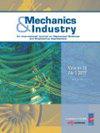Temperature rise characteristics of the valve-controlled adjustable damping shock absorber
IF 1.2
4区 工程技术
Q3 ENGINEERING, MECHANICAL
引用次数: 6
Abstract
The thermodynamic study of the valve-controlled adjustable damping shock absorber is conducted in order to solve the problem of oil leakage caused by excessive temperature rise of shock absorber. In this paper, the temperature rise of the valve-controlled adjustable damping shock absorber is analyzed from the perspective of energy conservation. Combined with the theory of fluid mechanics, the damping heat model is established, and the heat dissipation model of the shock absorber is established based on heat convection, heat conduction and heat radiation. The corresponding thermal equilibrium equation is established on the basis of damping heat and heat dissipation. The effects of vibration velocity, outer diameter, thickness and length of reservoir cylinder, and wind velocity on its thermal performance have been investigated. Specifically, temperature after thermal equilibrium will grow with the increase of vibration velocity and thickness of reservoir cylinder and degrade with the increase of outer diameter, length of reservoir cylinder and wind velocity. The higher the balance temperature, the shorter time is required to arrive thermal equilibrium. The difference between the experimental and simulation values of oil temperature after thermal equilibrium was not more than 2 °C, which verified the correctness of the theoretical model, while the experimental value in the process of temperature rise lagged behind the simulation value, which was mainly caused by the cumulative error of step-by-step iteration and the mechanical hysteresis in the experiment. The conclusions obtained can provide some references for the design of shock absorbers.阀控可调阻尼减振器的温升特性
为解决减振器温升过高造成的漏油问题,对阀控可调阻尼减振器进行了热力学研究。本文从节能的角度对阀控可调阻尼减振器的温升进行了分析。结合流体力学理论,建立了阻尼热模型,建立了基于热对流、热传导和热辐射的减振器散热模型。在阻尼散热和散热的基础上,建立了相应的热平衡方程。研究了振动速度、储气罐外径、储气罐厚度和长度以及风速对储气罐热工性能的影响。其中,热平衡后温度随振动速度和储气罐厚度的增加而升高,随储气罐外径、长度和风速的增加而降低。平衡温度越高,达到热平衡所需的时间越短。热平衡后的油温实验值与模拟值相差不大于2℃,验证了理论模型的正确性,而温升过程中的实验值滞后于模拟值,这主要是由于分步迭代的累积误差和实验中的机械滞后造成的。所得结论可为减震器的设计提供参考。
本文章由计算机程序翻译,如有差异,请以英文原文为准。
求助全文
约1分钟内获得全文
求助全文
来源期刊

Mechanics & Industry
ENGINEERING, MECHANICAL-MECHANICS
CiteScore
2.80
自引率
0.00%
发文量
25
审稿时长
>12 weeks
期刊介绍:
An International Journal on Mechanical Sciences and Engineering Applications
With papers from industry, Research and Development departments and academic institutions, this journal acts as an interface between research and industry, coordinating and disseminating scientific and technical mechanical research in relation to industrial activities.
Targeted readers are technicians, engineers, executives, researchers, and teachers who are working in industrial companies as managers or in Research and Development departments, technical centres, laboratories, universities, technical and engineering schools. The journal is an AFM (Association Française de Mécanique) publication.
 求助内容:
求助内容: 应助结果提醒方式:
应助结果提醒方式:


